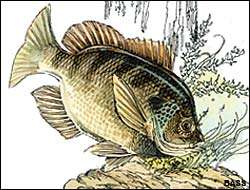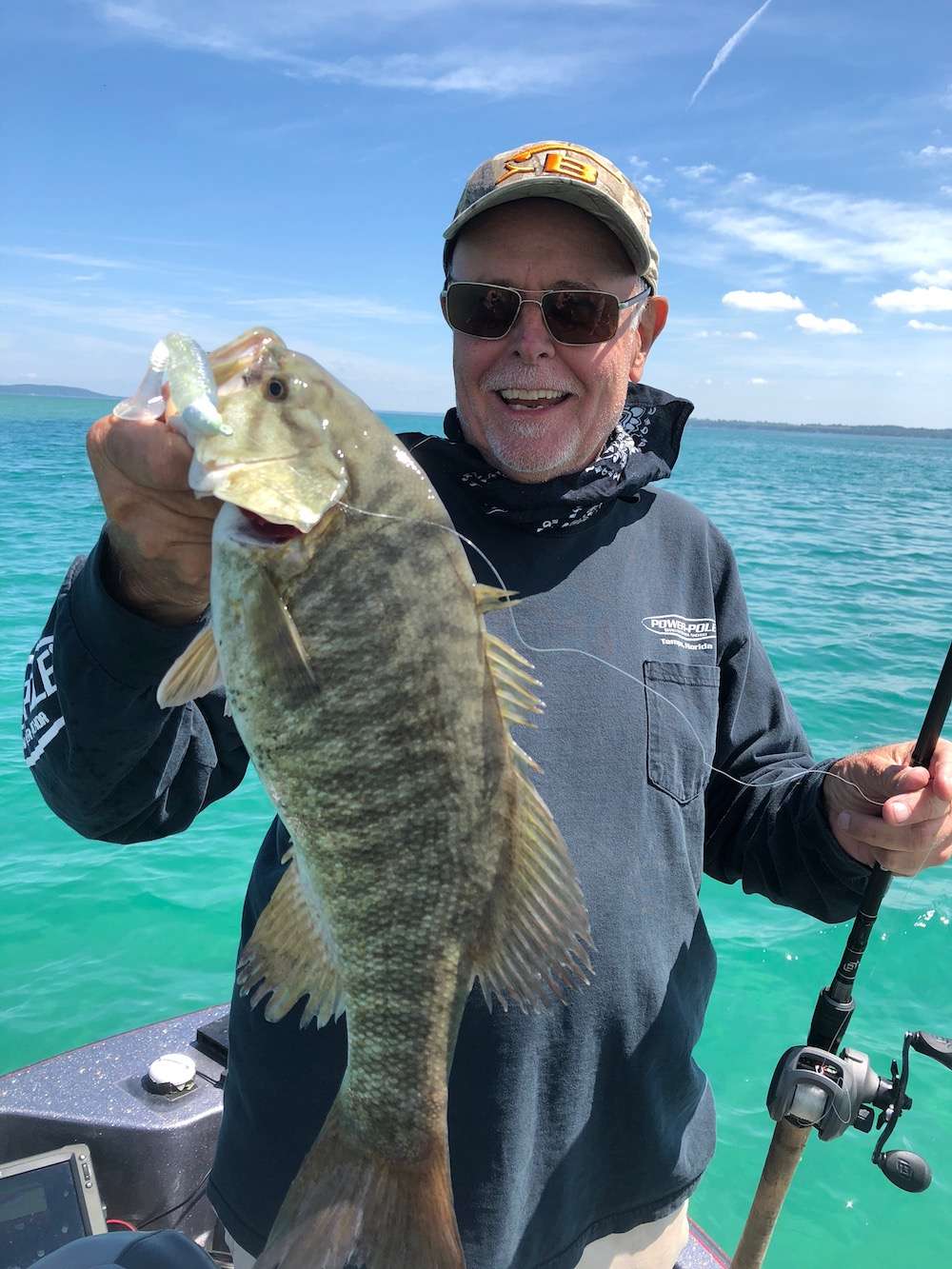
Bass are great fun to catch, but there are plenty of other fish that can put a bend in your rod and a smile on your face! Here are some of our favorites.
Bluegill
Also known as bream, pumpkinseed and shellcracker, bluegill are small but mighty fighters that you can catch in most lakes and ponds. They often run in large schools and will bite hooks baited with worms or crickets or small artificial lures like tube jigs and spinners. Bluegill have taught more kids the thrill of fishing than most other fish species combined — they're always hungry!
Where bluegill live — Bluegill love weedy lakes and like to hide in shadows (like under boat docks), then rush out to grab a meal.
Hot tip — You don't even need to know how to cast to catch bluegill! Just tie about 6 feet of line to the end of a cane pole; tie a small hook to the end of the line, and bait up with a redworm or cricket. Pinch a bobber about 18 inches above the hook, and simply lower the bobber and bait into the water. Let the bobber sit still for a few minutes, and keep your eye on it. Sooner or later it'll disappear under the surface. Give the pole a quick jerk, and you'll have a scrappy bluegill on the end of your line!
Carp
Bass fishermen often badmouth these big fish, but they're a challenge to catch — anglers who fish seriously for carp know they're among the hardest freshwater fish to fool into biting. Carp eat tiny insects and worms that live on the bottom and can often be seen stirring up a trail of mud as they swim slowly along, feeding as they go. Some varieties of carp eat weeds and can devour their weight in vegetation in a single day. Carp may grow to more than 30 pounds and pull like crazy when you hook them!
Where carp live — Carp inhabit the shallows of most lakes, ponds and rivers. Look for them near the edges of shoreline grass and around boat docks.
Hot tip — If you bait the same hole several days in a row, you can attract carp to it. Toss a handful of whole kernel corn into the water, repeating this several times over the course of a week, making sure you toss the corn out in the same spot every time. Then thread two or more kernels of corn onto a small hook and toss it out into the same area you've baited. A big carp will pick up your corn and run with it, so stay alert or it'll pull the rod right out of your hands!
Catfish
These fish get their name from their whiskers, which fish scientists call barbels. These contain scent organs and allow a catfish to find food in the darkest, muddiest water. There are many varieties of catfish in the United States. The most popular with serious fishermen are channel, flathead and blue catfish, while kids love to catch the much smaller bullhead. Channel and bullhead cats are often stocked in ponds and are easy to catch from shore. Flathead and blue catfish are more common in lakes and rivers, where they can grow to weights of more than 100 pounds!
Where catfish live — Like bass, flathead catfish like to hang around sunken wood cover. They often feed at night. Channel cats and bullheads prowl both holes and shallow areas of lakes and ponds, while blue cats prefer cold water and current and may live at depths of 50 feet or more.
Hot tip — Catch a big cat on a hot dog! Cut an uncooked wiener into chunks; thread it on a strong hook, and fish it on the bottom with a heavy sinker for weight. Catfish will also eat chicken livers, chunks of shad, live bluegill, even pieces of Ivory soap!
Crappie
Crappie are common in lakes and reservoirs. A big one weighs 2 pounds. Most weigh a pound or less. They school in large numbers to dine on minnows. Crappie are a tasty food fish and, like bluegill, are pretty easy to catch once you find them. They'll hit small minnows fished under a bobber as well as small tube jigs and spinners.
Where crappie live — Crappie are found around sunken wood and brush cover, especially in reservoir tributary arms. Anglers often sink their own crappie cover in the form of tree limbs lashed together and weighted with concrete blocks, or wood stakes driven into the soft bottom of the lake. Crappie will gather around this cover to feed and spawn, and once you know where it is, you can go back day after day and catch fish.
Hot tip — If you don't know whether the crappie in your home lake want minnows or tube baits, why not give 'em both? Make a Kentucky rig by tying a heavy sinker (3/4 to 1 ounce) to the end of your line. Next, tie a small tube jig a foot above the sinker and a wire hook a foot above the tube bait. Bait the hook with a lively minnow; lower the rig straight down to the bottom close to cover, then reel it up s-l-o-w-l-y. If a school of crappie is there, you may catch two at once!
Pike and musky
These toothy critters inhabit weedy lakes, especially in the Midwest, and feed mostly on other fish. They'll rush out and grab prey in their sharp teeth, swim around with it awhile, then swallow it headfirst. Pike are greenish with chainlike markings on their sides, while muskies have spots or stripes. Both species will strike spinnerbaits, big minnow plugs and noisy topwater lures.
Where pike and muskies live — These predators hang around weedbeds, submerged trees and other shallow cover.
Hot tip — Big pike and muskies are bad about following your lure to the boat without striking. When your bait nears the boat, swish it through the water in a figure-eight pattern a few times — this may provoke an instant strike from a following fish!
Trout
Trout prefer cold, clean water and thrive in fast flowing rivers and streams. They eat insects, minnow and crawfish. Rainbow trout have bright red or pink sides, while brown trout are spotted. Large trout are extremely wary and require great skill (and luck) to catch.
Where trout live — Rainbow trout can be caught on shallow shoals, in deep holes and close to undercut stream banks. Brown trout are more cover oriented and lurk around trees and log jams on stream bottoms.
Hot tip — Since trout eat insects, anglers often use tiny flies to catch them. You don't need a flyrod to cast a fly: Pick up a "plastic bubble" (a clear plastic device somewhat like a bobber that attaches to your line) at a tackle shop. Tie a fly to the end of your line, then place the bubble from 18 inches to 3 feet above the fly. The bubble will add enough weight for easy casting, yet easy-to-spook trout can't see it. Cast bubble and fly upstream and let it drift back downstream with the current. When the bubble disappears, a trout has grabbed your fly!





